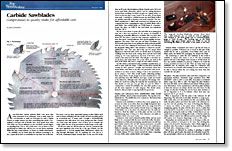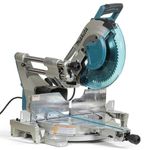Carbide Sawblades
Compromises in quality make for affordable cuts
Synopsis: Jim Cummins has come up with two rules for sawblades: Don’t spend more than 15% of the cost of your tablesaw on any one blade, and figure on spending from 25% to 50% of the saw’s cost on three or four special-purpose blades that will let you cut just about anything. He says the most important thing is the type of blade, not the manufacturer. He explains grades and tolerances, what the plate should be made of, how carbide is made and applied, and the number of teeth you should look for. The extensive discussion of grinds is supported by a detailed illustration. How the carbide has been sharpened matters, too.
A top-of-the-line carbide tablesaw blade costs more than some motorized 10-in. tablesaws. Does it make sense for a woodworker to shell out $100-plus for such a blade? There’s no single answer, but after researching this article, I formulated a two-part rule of thumb: First, don’t spend more than 15% of the cost of your tablesaw on any one blade; second, figure on spending from 25% to 50% of the saw’s cost on three or four special-purpose blades that will let you cut just about anything. While this may sound arbitrary, it’s based on careful observations.
No sawblade can be better than the tablesaw powering it. In fact, I spent about $900 on sawblades for my Sears saw in the first five years I ran my shop, ignorantly buying toothier blades each time in hopes of finding one that would cut both smoothly and at an economical rate. It wasn’t until I bought a Rockwell/Delta Contractors Saw with about 50% more horsepower that I found out I had some real winners. Four of these are in constant use today, while the rest of my investment mostly hangs on the wall.
I’ll tell you what my old favorites are, but I’m convinced that the most significant part of my list is the type of blade, not the manufacturer: a 10-tooth ripping blade (Winchester), which can slog through full-depth cuts on anything I’ve ever fed it; a 40-tooth combination blade (Freud) that’s on the saw 95% of the time; an 80-tooth, thin-kerf plywood blade (Freud); and a 120-tooth no-set steel blade (Simonds), which I use for cutting aluminum picture-frame molding, but which can give me a glassy surface on wood on the few days a year I want it. At one time, all my blades were steel. I switched to carbide because my steel blades dulled too quickly, especially in abrasive, man-made materials. One sawblade manufacturer I talked with mentioned an informal test his company had done comparing two types of carbide blades with a steel blade. One carbide blade cut 12,000 linear ft. of particleboard; the other cut 9,000 ft.; the steel blade was hopelessly dull after 300 ft.
From Fine Woodworking #70
For the full article, download the PDF below:
Fine Woodworking Recommended Products

Makita LS1219L Miter Saw

Craftsman Random Orbit Sander

Veritas Precision Square





















Log in or create an account to post a comment.
Sign up Log in